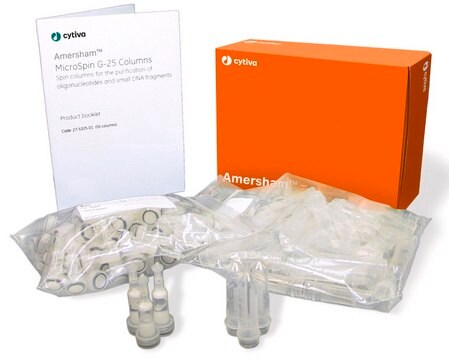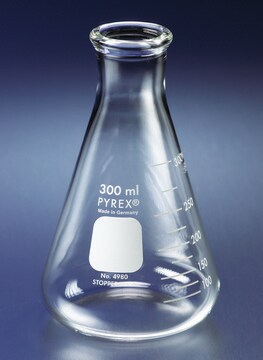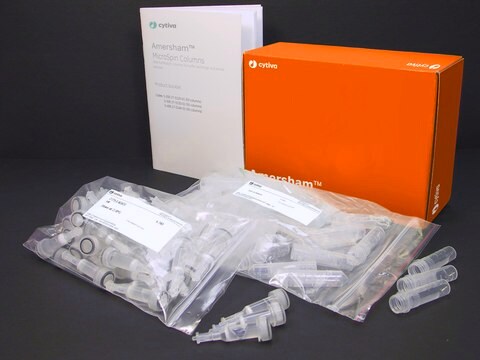GE28-9034-08
ProbeQuant™ G-50 Micro Columns
Cytiva 28-9034-08, pack of 50 columns
Synonym(s):
Micro Columns
Sign Into View Organizational & Contract Pricing
All Photos(1)
About This Item
UNSPSC Code:
41105501
NACRES:
NA.52
Recommended Products
material
resin (Sephadex G-50 DNA Grade)
sterility
non-sterile
packaging
pack of 50 columns
manufacturer/tradename
Cytiva 28-9034-08
working volume
25—50 μL
particle size
50-150 μm (dry)
pore size
30 kDa MWCO
Related Categories
General description
ProbeQuant™ G-50 Micro Columns use spin-column chromatography to provide a fast and reliable method for purifying labeled probes from unincorporated labeled nucleotides.
ProbeQuant™ G-50 Micro Columns use spin-column chromatography to provide a fast and reliable method for purifying labeled probes from unincorporated labeled nucleotides. In addition, a portion of the eluted DNA can be counted in a scintillation counter and compared to an unpurified sample to give an approximation of percent incorporation. The columns are designed for use in a microcentrifuge, come prepacked with Sephadex® G-50 DNA grade and are pre-equilibrated in STE, which means that they are ready to use. They can accommodate samples ranging in volume from 25 μ to 50 μ.
ProbeQuant™ G-50 Micro Columns use spin-column chromatography to provide a fast and reliable method for purifying labeled probes from unincorporated labeled nucleotides. In addition, a portion of the eluted DNA can be counted in a scintillation counter and compared to an unpurified sample to give an approximation of percent incorporation. The columns are designed for use in a microcentrifuge, come prepacked with Sephadex® G-50 DNA grade and are pre-equilibrated in STE, which means that they are ready to use. They can accommodate samples ranging in volume from 25 μ to 50 μ.
Features and Benefits
- For rapid purification of labeled DNA (20 bases) from unincorporated labeled nucleotides in a volume of 25 to 50 μ using spin-column chromatography
- Convenient: Prepacked with Sephadex® G-50 DNA Grade (see illustra™ Sephadex® G-50 and G-100 DNA Grade) and pre-equilibrated in STE containing 0.15% Kathon CG/ICP Biocide
- Ready to use: Requires less than 4 min from sample application to collection of purified product
- Designed for use in a microcentrifuge
- Tested in nickase, single and double-stranded exonuclease and RNase assays
Storage and Stability
Please be aware this product may be shipped 90 days before the expiration date. For more information on the batch specific expiration date, please contact technical service.
Store at 4 to 30 °C ()
Analysis Note
To view the Certificate of Analysis for this product, please visit www.cytiva.com.
Legal Information
ProbeQuant is a trademark of Cytiva
Sephadex is a registered trademark of Cytiva
illustra is a trademark of Cytiva
Signal Word
Warning
Hazard Statements
Precautionary Statements
Storage Class Code
12 - Non Combustible Liquids
Choose from one of the most recent versions:
Certificates of Analysis (COA)
Lot/Batch Number
It looks like we've run into a problem, but you can still download Certificates of Analysis from our Documents section.
If you need assistance, please contact Customer Support.
Already Own This Product?
Find documentation for the products that you have recently purchased in the Document Library.
Customers Also Viewed
K Higuchi et al.
Plant physiology, 119(2), 471-480 (1999-02-10)
Nicotianamine synthase (NAS), the key enzyme in the biosynthetic pathway for the mugineic acid family of phytosiderophores, catalyzes the trimerization of S-adenosylmethionine to form one molecule of nicotianamine. We purified NAS protein and isolated the genes nas1, nas2, nas3, nas4
R J Akhurst et al.
International journal of systematic and evolutionary microbiology, 54(Pt 4), 1301-1310 (2004-07-29)
The relationship of Photorhabdus isolates that were cultured from human clinical specimens in Australia to Photorhabdus asymbiotica isolates from human clinical specimens in the USA and to species of the genus Photorhabdus that are associated symbiotically with entomopathogenic nematodes was
Bogac Kaynak et al.
Circulation, 107(19), 2467-2474 (2003-05-14)
We present the first genome-wide cDNA array analysis of human congenitally malformed hearts and attempted to partially elucidate these complex phenotypes. Most congenital heart defects, which account for the largest number of birth defects in humans, represent complex genetic disorders.
C H C Halsey et al.
Journal of animal science, 89(4), 1011-1019 (2010-12-15)
The long-term effect of feeding the catecholamine analog ractopamine (RAC; ractopamine hydrochloride, Elanco Animal Health, Indianapolis, IN) on the expression of genes involved in energy and lipid metabolism in subcutaneous adipose tissue was studied. Large White pigs (84 kg) were
Nozomu H Nakamura et al.
The Journal of neuroscience : the official journal of the Society for Neuroscience, 33(28), 11506-11514 (2013-07-12)
A prevailing view in memory research is that CA3 principally supports spatial processes. However, few studies have investigated the contribution of CA3 to nonspatial memory function. Interestingly, the proximal part of CA3 (close to the dentate gyrus) predominantly projects to
Our team of scientists has experience in all areas of research including Life Science, Material Science, Chemical Synthesis, Chromatography, Analytical and many others.
Contact Technical Service













